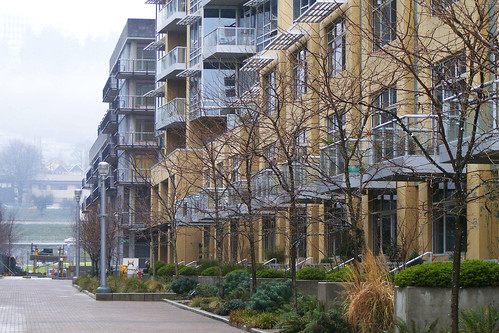 |
| "Real doors" in Portland. All photos by the author unless noted. |
NOTE: This content was developed for the Friends of White Flint blog, though you'll find examples of "real doors" around downtown Silver Spring, especially in the Ripley District currently under construction.
Houses have their perks: a yard, a private entrance, and a sense of individuality. Apartments have theirs as well: they're affordable, low-maintenance, and have lots of shared amenities. What if you could get best of both worlds? Several new apartment communities being built in White Flint do just that with something called "real doors."
What are "real doors"? Basically, it's when a multi-family building contains ground-floor apartments or rowhouses with private entrances opening directly to the street. Instead of walking by blank walls or loading docks, you'd pass doors, stoops, porches and more importantly, people.
This is by no means a new idea, but "real doors" have become especially relevant as a way to give large buildings human scale. Danish urban designer Jan Gehl notes that our field of view doesn't go far above eye level, so most pedestrians only pay attention to details at the street level. You might think you're walking by a block of rowhouses, but they could just be the base of a high-rise.
"Real doors" also make streets safer by providing more "eyes on the street." They give residents the privacy and individuality of a house with the communal amenities and low maintenance of an apartment. And they allow architects and developers to provide so-called "missing middle" house types that could accommodate families, like rowhouses, in areas where land values are so high that they're not economically feasible.
I got to see the benefits of "real doors" firsthand in Philadelphia, where for two years I lived on the ground floor of a 100-year-old house that had been turned into apartments decades ago. My roommate and I had affordable rent, just enough space and a doting landlord. We could also walk out from our living room to the front porch, out to the street, and around to the back yard, which made it feel like a house.
"Real doors" have become part of the design culture in places like Vancouver, where former planning director Brent Toderian jokes that they're great for trick-or-treating. Residential projects across Greater Washington have started including them as well. "Real doors" will become a common design feature in White Flint, as it supports the urban design goals of its Sector Plan. Two projects being built there, Pike + Rose and Archstone Old Georgetown Road, will include them.
However, not all "real doors" are created equal. Done poorly, they can look like an afterthought, feel anonymous and compromise privacy. Let's look at some examples from around the area and the country:
GOOD
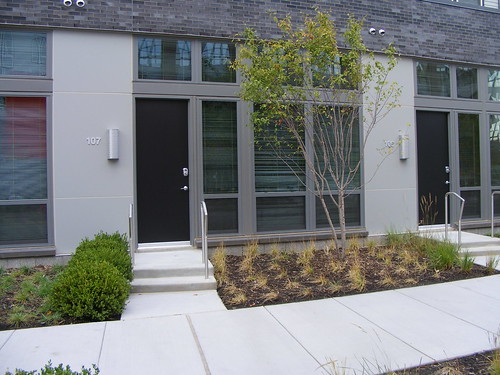 |
| Ground-floor apartment at Halstead Square in Merrifield. |
These are "real doors" at Halstead Square, an apartment and retail complex being built in Merrifield. (Check out some more pictures.) These doors belong to single-story, one-bedroom apartments, and each one has a little stoop and an address number. The floor-to-ceiling windows are nice, but they're so close to the ground that people walking by can easily look in.
 |
| Tall stoops at Citron in Silver Spring. |
At Citron, an apartment building under construction in downtown Silver Spring, "real doors" help it relate to the single-family homes across the street. The ground-floor units are high enough to be private, which would've been a nice opportunity to expand those stoops into porches.
BETTER
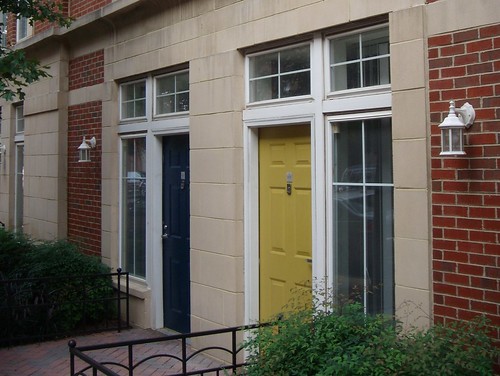 |
| Ground-floor duplexes at the Market Common in Clarendon. |
These ground-floor rowhouses at the Market Common in Clarendon each have different-colored doors, giving them their own identity. The building as a whole has similar materials and detailing as the actual rowhouses at the end of the block, helping it blend in.
 |
| "Real doors" with private yards at the Silverton. Image from Google Street View. |
These "real doors" at the Silverton in South Silver Spring are set back from the street, which provides room for a semi-private, gated patio with enough room for a table and chairs. Though they have big, low windows like Halstead Square, the trees help give shade and privacy. I might have made the doors themselves more distinctive, perhaps with a different paint color or frosted glass panels.
BEST
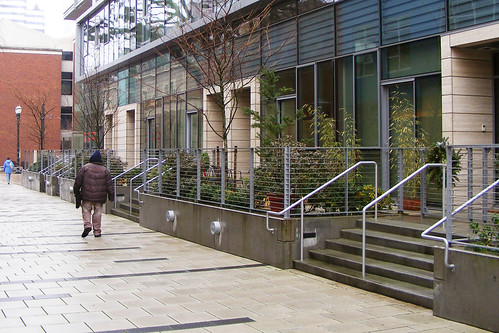 |
| These rowhouses at Eliot Tower in Portland have raised decks. |
The best "real doors" I've found are on the West Coast. This is the Eliot Tower in downtown Portland, a tower with two-story rowhouses at its base. Each house has a front deck raised several steps above the street, and you can see how each deck has a tree or some leafy plants for privacy and visual impact.
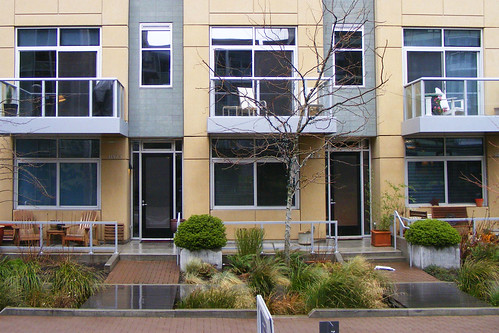 |
| Rowhouses with yards at the Meriwether in Portland. |
At the Meriwether, a tower in Portland's Southwest Waterfront, there are ground-floor rowhouses set behind little yards. Not only do they provide a buffer from the street, but they appear to be part of a bioswale that collects and filters runoff water before it heads to the Willamette River, a few hundred yards away. You can see each house has decks on multiple floors, giving it plenty of outdoor space. And residents have them their own, judging from these hot pink Adirondack chairs.
WORST
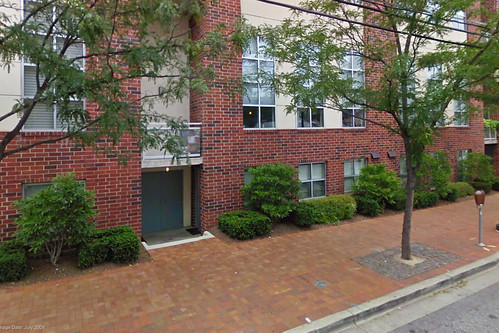 |
| Less-than-great "real doors" at Lofts 24 in Silver Spring. Image from Google Street View. |
Believe it or not, this is the entrance to two ground-floor condominiums at Lofts 24, also in downtown Silver Spring. Other than the welcome mat outside the door on the right, there's no indication that people actually live here.
Rather than a house, this feels like the entrance to a storage unit. There are no street numbers, no individual open space, and no buffer from the street. The only landscaping are bushes that cover the windows.
Check out these examples of "real doors" from around the region and country.
While these examples aren't perfect, they show the opportunities and challenges of providing "real doors." The scale of development in many urban neighborhoods has gotten bigger, but humans generally remain the same size, so we still have to design to that scale.
Not only can "real doors" make otherwise big buildings feel more comfortable, but they can make safer and more visually attractive streets and offer people a desirable mix of house and apartment living. That is, if we do them right.

4 comments:
There are some new buildings in the Carlyle neighborhood of Alexandria that have this. I always wondered what the deal was--whether they were condos or town homes (at least some of them appear to be multi-floor).
I live in one of those "Worst" ground-level doors in Lofts 24.
Agree 100% that they had huge potential for street-level appeal, but as it stands now, they look like utility closets!
On the other hand, no other buildings in DTSS offer the high-ceiling contemporary units that Lofts 24 has. Not sure why... developers in DC seem more willing to embrace the aesthetic.
Thanks, great overview of an interesting topic, on the street side. I'm wondering about the other side: do these ground-floor units also have rear doors leading to a standard double-loaded corridor, or maybe there's no corridor and the units go all the way through the building? I'm sure designs vary; what do you think works best?
@Ryan
It depends on the complex - the ground-floor units at the Eliot Tower go through the building and have little yards in the back, while the ones at the Silverton (I believe) back to a corridor inside the building.
They both have their merits, and I think it depends on the unit and the building. For instance, townhouse-style units like at Eliot Tower might draw families, in which case having the backyard is really valuable, while single-story flats like at the Silverton or the Citron might draw people more interested in convenience, and having internal entrances mean they can access the building's amenities (lobby, common areas, trash room) without having to go outside.
Post a Comment